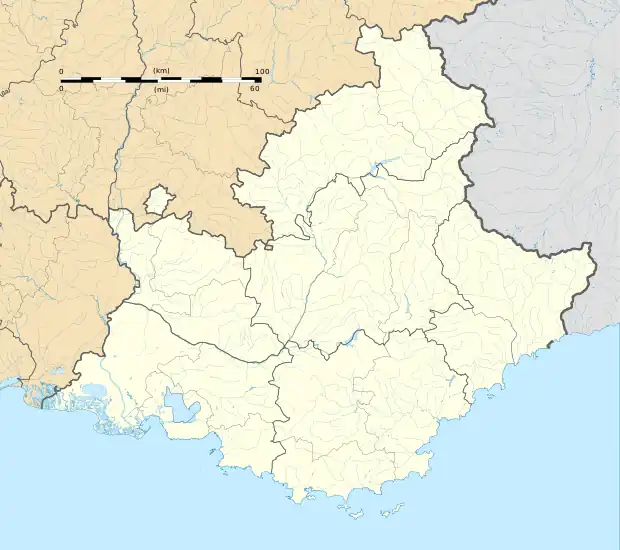Puget-Rostang | |
|---|---|
 A view of the village from the St Catherine path | |
 Coat of arms | |
Location of Puget-Rostang | |
 Puget-Rostang  Puget-Rostang | |
| Coordinates: 43°58′29″N 6°55′06″E / 43.9747°N 6.9183°E | |
| Country | France |
| Region | Provence-Alpes-Côte d'Azur |
| Department | Alpes-Maritimes |
| Arrondissement | Nice |
| Canton | Vence |
| Government | |
| • Mayor (2020–2026) | Philippe Hachet[1] |
| Area 1 | 22.46 km2 (8.67 sq mi) |
| Population | 126 |
| • Density | 5.6/km2 (15/sq mi) |
| Time zone | UTC+01:00 (CET) |
| • Summer (DST) | UTC+02:00 (CEST) |
| INSEE/Postal code | 06098 /06260 |
| Elevation | 537–1,738 m (1,762–5,702 ft) (avg. 771 m or 2,530 ft) |
| 1 French Land Register data, which excludes lakes, ponds, glaciers > 1 km2 (0.386 sq mi or 247 acres) and river estuaries. | |
Puget-Rostang (French pronunciation: [pyʒɛ ʁɔstɑ̃]; Occitan: Lo Puget Rostanh; Italian: Poggetto Rostang) is a commune in the Alpes-Maritimes département in southeastern France.
Geography
The commune is traversed by the Cianavelle and the Raton River.
It is located 70 km (43 mi) from Nice and 6 km (3.7 mi) from Puget-Théniers, seat of the canton.
The climate is Mediterranean, tempered by the 700 m (2,300 ft) altitude. Winters are brisk, but with no snow.
The village lies at the confluence of the Mairola and the Riou d’Auvare. The valley of the Mairola lies east and west and is dominated by the Mount Cimaillon (1514 m), which was topped by a castle.
Economy
Until the middle of the 19th century, the village raised just enough to feed itself. Grain grew poorly in the rocky soil, and the vineyards only provided enough for family consumption. Each family had a few sheep and a couple of goats. The only notable product was prunes.
Since that time, artisanal products have dominated the economy. An eco-museum featuring tools and implements attracts visitors to the region.
Population
| Year | Pop. | ±% p.a. |
|---|---|---|
| 1968 | 61 | — |
| 1975 | 70 | +1.99% |
| 1982 | 85 | +2.81% |
| 1990 | 115 | +3.85% |
| 1999 | 114 | −0.10% |
| 2009 | 105 | −0.82% |
| 2014 | 133 | +4.84% |
| 2020 | 126 | −0.90% |
| Source: INSEE[3] | ||
See also
References
- ↑ "Répertoire national des élus: les maires". data.gouv.fr, Plateforme ouverte des données publiques françaises (in French). 2 December 2020.
- ↑ "Populations légales 2021". The National Institute of Statistics and Economic Studies. 28 December 2023.
- ↑ Population en historique depuis 1968, INSEE